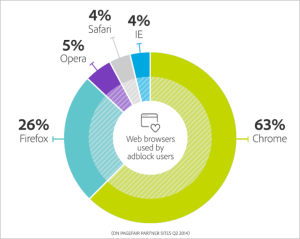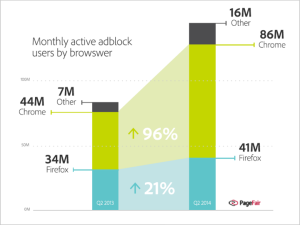Orange Juice
Your
quarterly
vitamin.
Adblocking, Apple and the Impact to Advertisers
Written on 09/28/15 9:43 PM
![stopads[1]](https://rpmadv.com/wp-content/uploads/2015/09/stopads1.jpg)
 The new Apple iOS 9 operating system set to launch in fall 2015 will include an ad blocking feature for Web browser Safari, called “Content Blocking”. This will give consumers the ability to block cookies, images, resources, pop-ups, and other content. Adblockers work by blocking HTTP and HTTPS requests based on the source address; they keep a running list of addresses of known advertisers, making sure that the banners and bugs from those ad networks do not show. They also can block extras like Flash (no auto-playing animated ads). It will, though, be an extension to the Safari browser that requires a separate download from the Apple Store and managed independently via the Settings.
The new Apple iOS 9 operating system set to launch in fall 2015 will include an ad blocking feature for Web browser Safari, called “Content Blocking”. This will give consumers the ability to block cookies, images, resources, pop-ups, and other content. Adblockers work by blocking HTTP and HTTPS requests based on the source address; they keep a running list of addresses of known advertisers, making sure that the banners and bugs from those ad networks do not show. They also can block extras like Flash (no auto-playing animated ads). It will, though, be an extension to the Safari browser that requires a separate download from the Apple Store and managed independently via the Settings.
Adblocking on desktops isn’t new. According to a 2014 study by PageFair & Adobe, there are approximately 144 million active adblock users around the world, an increase of 69% since 2013. Further, 27.6% of U.S. internet users say they use adblocking software. It’s exceptionally popular with millennials, 41% of whom claim to use adblock software.
Apple is making it possible to adblock beyond the desktop. Consumers have an incentive to block ads on mobile devices – ads use up data, slowing down mobile devices and potentially running up bills. The additional content also runs down batteries faster. Privacy is a huge concern as well. And of course, ads can be perceived as intrusive or annoying. According to eMarketer, 59% of mobile web traffic in the US was done via the Safari so at least 41% of the market is unaffected. Right now, it’s difficult to estimate how many people will download and install the extension. But as usage grows for desktop computers; one can assume it will be popular for mobile as well.
Apple claims they want to give users control of their experience but some believe this is a new conquest of ad space for iAd, their own mobile ad platform. It delivers ads for iOS apps via the operating system, which one can only assume will never be blockable. Some believe it’s a move by Apple to shut out rival player Google, which derives more than 90% of its revenue from online advertising. A huge share of that is from mobile – mostly via Apple devices.
Whatever the motivation, industry executives are fearful of the impact on their revenue streams. It’s already difficult to monetize mobile ads. For example, more than 50% of The New York Times digital audience comes from mobile, but it generates only 10% of its digital advertising revenue. Advertisers are concerned about reaching potential customers, especially highly valued Apple users.
Some things publishers and advertisers can do to combat adblocking include:
- User experience: Many people ad-block simply because some ads are intrusive like auto-play videos and pop-ups. So limiting the use of these types of ads improves the user experience.
- Native advertising: Advertisers are seamlessly woven into the online experience by sponsoring or providing content
 the consumer desires.
the consumer desires. - In-app ads: Include in-app ads in the digital mix whether through iAd or another partner using an array of apps which increases reach.
- Social media: Using social media offers conversation and interaction with brand fans that are controlled by the platform and can’t be ad-blocked.
Almost as quickly as adblocking has become a hot-button issue, new concerns have already begun changing the landscape. Recently, Apple removed some adblockers from its App Store. Although ad content within Safari was enabled by the company, some apps block ads on other apps by installing root certificates that funnel a user’s entire web traffic through a proxy service which filters out any advertising.
These apps have been deemed as dangerous by Apple because of privacy and security concerns including the idea that a customer’s network data could be censored or monitored by a third party. Even if preventing wholesale adblocking outside Safari is in Apple’s best interest, it’s also good news for advertisers.
Adblocking is an important trend to watch. Especially as the ability becomes more readily available on mobile devices.